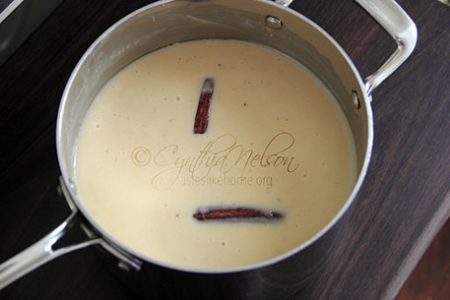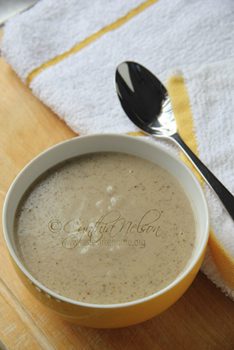Hi Everyone,
Despite being someone who does not like porridge, I have fallen deeply in love with plantain flour porridge.
 I had never eaten plantain porridge until a month ago. I grew up on Quaker Oats, Cream of Wheat, sago, and to a lesser extent, cornmeal. It is not that I was unaware of plantain flour porridge; it is just that it was not something my mom made and as an adult, I had never sought to make it. Besides, I grew up thinking of it as baby food.
I had never eaten plantain porridge until a month ago. I grew up on Quaker Oats, Cream of Wheat, sago, and to a lesser extent, cornmeal. It is not that I was unaware of plantain flour porridge; it is just that it was not something my mom made and as an adult, I had never sought to make it. Besides, I grew up thinking of it as baby food.
As a young child, I’d see my aunt, Betty, patiently sit and peel several pounds of green plantains, slice them thinly, lengthways, carefully lay them out in an orderly fashion on a clean piece of zinc sheet and put it in the sun to dry. In morning the sheet with plantains were positioned to get optimal exposure to the sun and then after lunch, the sheet was moved to get the full brunt of the midday to late afternoon sun.

I cannot recall how many days it took for the plantains to dry and harden. I remember the colour of the plantains changing to a pale, almost seashell colour, the rich cream-colour of the fresh plantains, faded. The dried plantain slices would be broken, snapped into smaller pieces and put through the mill to be ground to a powder. Auntie Betty would use the plantain flour to make porridge for her very young grandchildren. I figured that the plantain flour porridge must have in some special nutrients that could not be had from the Similac and Lactogen baby formula they were being fed. See why I thought of it at as baby food?
Green plantains are often touted as a rich source of iron (non-heme), it is not really so, green plantains only contain 5 – 6% of our daily-recommended intake of iron. However, green plantains are a rich source of Vitamins C, A, B6, and the minerals – potassium and magnesium. Add these nutrients to milk which is full of bone-building and bone-strengthening calcium and it is a no-brainer as to why plantain porridge would be fed to babies and growing children.

I bought a packet of plantain flour produced by the Guyana School of Agriculture for the sole purpose of making porridge. I felt like trying it. There were no instructions on the package so I asked Auntie Betty for guidance and set about making plantain flour porridge. Listen, I do not know if it was the sweetness from the sugar or the creaminess of the fresh cow’s milk and evaporated milk combined but this porridge had me wide-eyed, admiring and savouring every spoonful, talking to myself about how wonderful it tasted. I was surprised. I had no idea what the porridge would taste like. It reminded me a little of Cream of Wheat. I ate the porridge before I went off to work and as I exited the house, I promised myself that I would make more porridge in the evening so that I could sit and enjoy it properly. Yes, you read that correctly, I made the porridge twice in one day and that was all I ate that day – plantain porridge. Since I only bought one packet, I have been modest in my usage, opting to only make once a day, and not every day. I need to stock up on plantain flour.
In sharing my newfound delight of plantain flour porridge and my dilemma of running out of plantain flour, a friend suggested I make the porridge with fresh green plantains. I perked up. I could do that? Make amazing plantain porridge with fresh plantains? Why I asked myself, did I not know this? Major gap in my foodie knowledge!
I set about making the fresh plantain porridge by first pureeing the peeled and chopped plantain until smooth then cooking it low and slow with cinnamon and cloves, I added some vanilla towards the end. Then it was time to eat. What I would say is this, I liked it, and it tasted nice but it was not as delicious as the flour porridge version. I found it to be fresh and lighter in flavour. The porridge needed more spicing to enhance the overall flavour. The thing that wowed me about the fresh plantain porridge was the texture, it was silky smooth like a rich pudding and it had a texture that felt more like dessert. Actually the next time I make it, I will be making it as a pudding for dessert, I’ll add in some dried fruit like sultanas, raisins and maybe some cranberries. A few cherries too might be a good addition. I’ll chill it and serve it cold. Watch this space.
I definitely prefer the plantain porridge made from the flour – it has better flavour, more so when cooked with cinnamon and cloves. The texture is more appealing too; it has more body. There is a certain mouth feel you get and expect when eating porridge; I get that from the flour not the fresh plantain porridge. I need to stock up plantain flour to make porridge. It is a meal in itself.
Next week: A savoury plantain porridge with callaloo (spinach) and smoked fish.







